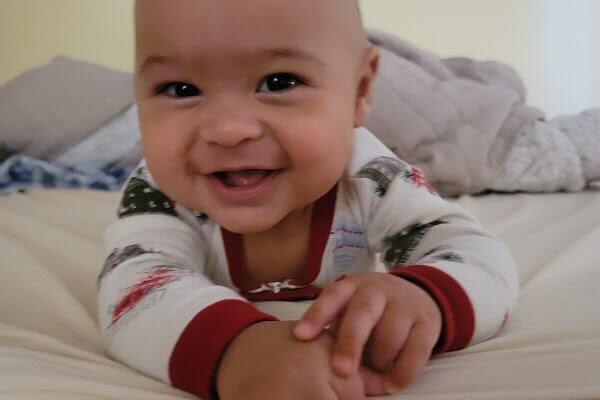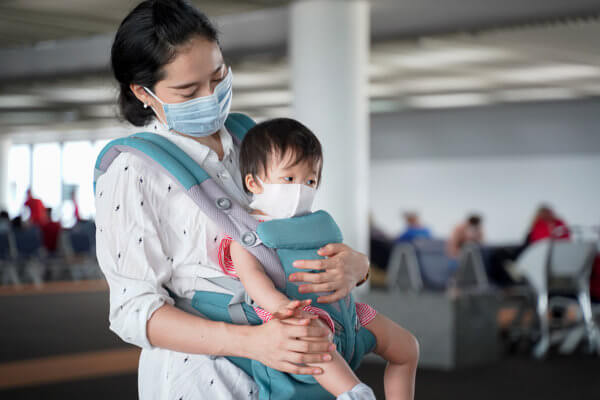By Alexa Joy Sherman
From the moment you give birth to your baby, you’ll be experiencing a whole lot of firsts with him: first smile, laugh, tooth, word, step-and, on the less popular side of the list, first (but certainly not last) illness. “Unless you put your baby in a bubble, she will get sick,” says Scott Cohen, MD, a Beverly Hills, Calif., pediatrician and author of Eat, Sleep, Poop: A Common Sense Guide to Your Baby’s First Year. “Children typically contract 10 to 12 illnesses before the age of 2.” That’s because babies are smaller, their immune systems are immature and they may not be fully vaccinated yet. Plus, kids aren’t just clueless about germs-they eagerly ingest them. “Babies drool, put toys in their mouths and don’t have the social graces to cover their coughs,” says Ari Brown, MD, a pediatrician in Austin, Tex., and coauthor of Expecting 411, Baby 411 and Toddler 411.
What’s a protective parent to do? A lot! “Breastfeeding can help boost the immune system,” says Cohen. “Getting antibodies from the mother definitely helps fight infection.” You can limit germ exposure, too: “Make sure everyone around the baby washes their hands and uses a hand sanitizer,” Cohen advises. “Don’t let anybody who seems even slightly under the weather near your infant, and keep small children-who tend to wipe their noses and mouths a lot-away from babies under the age of 2 months in particular.” Vaccinating against preventable illnesses is also essential for infants and those in their midst. Use OUR VACCINATION LOG to make sure your baby is on schedule for getting all of the immunizations recommended by the Centers for Disease Control and Prevention, the American Academy of Pediatrics and the American Academy of Family Physicians.
Of course, vigilant as you may be, the sick-baby odds may still win out. “However,” says Cohen, “most illnesses are not serious and can be easily managed.” It’s true. See for yourself.
NEXT: COLDS AND FLUS
{pagebreak}
Cold and Flu Comfort
Upper respiratory infections run rampant among the small set. The common cold and influenza (the flu) are two such conditions. With more than 200 different cold viruses floating around, it’s no wonder most babies will catch up to seven of them before their first birthday. There are only a few strains of the flu, which is why there’s a shot available for it-and babies 6 months and up can, and should, get it.
How It Looks: Babies with colds usually have stuffy or runny noses, beginning with a clear discharge that may become thicker and turn yellow or green, as well as coughing, sneezing, a sore throat (which may show up as a decrease in appetite) and/or a low-grade fever (under 102 degrees F). The flu is similar, but with a prolonged higher fever and more general discomfort. “The runny nose and cough arrive later and last longer, and secondary bacterial infections may occur more often with the flu,” adds Brown.
How to Deal: Try keeping baby upright as much as possible (you might let him sleep in an infant seat or place a pillow under the mattress to elevate the head, suggests Brown), running a humidifier to help loosen up mucus and/or using a little saline spray and bulb suction in the nose-but sparingly. Too much can cause irritation and increase congestion, Cohen explains. If your little one’s nasal passages are clogged, keep breast- or bottle-feedings shorter and more frequent, Cohen adds. For fever or general aches and pains, you can also give infant acetaminophen (Tylenol) to babies 3 months and older, and ibuprofen (Motrin, Advil) to those 6 months and up. Never give babies aspirin or cold and cough medicine. Also, since several potentially serious illnesses can start off looking like a cold-including respiratory syncytial virus (see “RSV: Not Just a Cold”), croup and whooping cough (see “Concerning Coughs: Barking and Whooping”)-call your doctor at the first sign of any cold-like symptoms in infants under 3 months old, and any time you feel symptoms are severe or prolonged thereafter.
NEXT: EAR PROBLEMS
{pagebreak}
Eluding Ear Evils
Sometimes viral, sometimes bacterial, ear infections (aka otitis media) are one of the most common reasons parents take their children to the doctor, and a full 75 percent of children will get at least one before they turn 3, according to the National Institute on Deafness and Other Communication Disorders. “Usually the child gets a cold and then fluid sits behind his eardrum, creating the setup for a secondary bacterial infection,” says Cohen.
How It Looks: Fever tends to be more common in infants and young children with ear infections, and some will tug at their ears or be fussy and have trouble sleeping-but because symptoms aren’t always apparent and a baby can’t tell you what’s wrong, it’s often tough for parents to detect.
How to Deal: Time and Tylenol may be all that’s required, but your doctor may also prescribe antibiotics-especially to infants. “There is now more of a wait-and-see approach with ear infections, especially in children over the age of 2, because the infection may be viral or clear on its own,” says Brown. “However, younger babies are more likely to have complications-so if they have a fever or other signs of illness, we’ll start antibiotics as soon as a diagnosis is made,” says Brown.
NEXT: TUMMY TROUBLE
{pagebreak}
Tummy-Trouble Tamers
Sometimes called “the stomach flu,” gastroenteritis can be caused by a variety of viruses, with rotavirus being the top contender for severe cases in children. “Prior to 2006, almost all kids got this infection by 3 years old,” says Brown. Since then, a rotavirus vaccine has become available-but that doesn’t mean your baby won’t get an upset stomach. After all, only 44 percent of children received the shot during infancy, according to the 2009 National Immunization Survey, and there are plenty of other issues eager to trouble your baby’s tummy.
How It Looks: Lots of diaper changes and laundry! “At best, your baby vomits once and has diarrhea for three to five days,” says Brown. “At worst, he vomits for 12 to 18 hours and has diarrhea 25 times a day for 10 days.” These symptoms may be accompanied by chills, clammy skin, excessive sweating and fever.
How to Deal: Your top priority is preventing dehydration-by offering small amounts of liquid. “The biggest mistake parents make is offering a huge amount of liquid as soon the baby throws up,” says Cohen. “But their bellies aren’t ready, so they’re just going to throw it back up.” Don’t offer water, either. “The body needs electrolytes to replace what’s lost-sodium, potassium, sugar-and water actually induces more vomiting,” Cohen explains. So after waiting at least 30 minutes, simply nurse your baby (if you’re breastfeeding), or offer 2 to 4 ounces of fluid (expressed breast milk, formula or an oral electrolyte solution such as Pedialyte) every 30 to 60 minutes by spoon, syringe or bottle.
As scary as first illnesses can be, they’re rarely cause for concern-and require little more than some TLC. However, nothing should trump your intuition. If you ever believe your baby’s symptoms suggest something serious, especially in those first few months, don’t hesitate to dial the doctor.
NEXT: COUGHS
{pagebreak}
Concerning Coughs: Barking and Whooping
If it starts like a cold and ends with your baby sounding like a canine, it’s probably croup-a viral infection that attacks the upper airway, causing fever and a bark-like cough, especially at night. Although this condition is impressive, it can be managed by spending 20 minutes in your bathroom with a steamy shower running, says Brown. If the airway tube becomes markedly swollen, “the bark changes to a high-pitched squeal,” Brown says, which requires a trip to the hospital for an emergency breathing treatment and steroids to reduce the swelling and keep the airway open.
Whooping cough (aka pertussis)-a bacterial infection and one of most common vaccine-preventable diseases in the United States-also begins like the common cold, but after a week or two, your child will have coughing fits, possibly “whooping” at the end of each as she gasps for air, or even vomiting. In either case, if your baby is having trouble breathing, if the cough becomes more severe or frequent, or if her lips or fingertips turn dark or blue, call your doctor immediately.
RSV: Not Just a Cold
While most children catch RSV before the age of 2 and don’t even know it (it usually clears up on its own in a week or two), in infants born prematurely and/or with heart or lung conditions, RSV can be serious and may require hospitalization. It is the most common cause of bronchiolitis (inflammation of the small airways in the lung) and pneumonia in children under the age of 1. Fortunately, infants with serious RSV usually only need to be hospitalized for a few days and make a full recovery in one to two weeks.
Find out what your infant is vulnerable to and how you can nurse them back to health.



